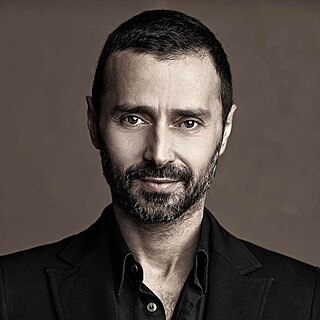
Arturo Dell'Acqua Bellavitis (born 1947) is the current director of the Milan Triennale Foundation and Exposition.

Arturo Dell'Acqua Bellavitis (born 1947) is the current director of the Milan Triennale Foundation and Exposition.
Apart from being the director of the Triennale, Bellavitis has his own architectural and design practice in Milan. [1] Among other customers, he has worked for Twinings, Nestlé, Renault and HGV.
Bellavitis has been a lecturer, and is now full professor of Industrial design, Interior design, Textile design and Fashion design at Polytechnic University of Milan in Milan, Italy. At the same university, he is also the director of the Polidesign project, chairman of the Fashion Design department, and since 1990 he has been the director of the master's degree in Design Management and Interior Design.
He has been visiting professor at many European and extra-European universities. He has lectured at the Royal Academy of Copenhagen (Denmark), at the Faculty of Architecture of Aarhus (Denmark), at De Montfort University (UK). He has conducted workshops at the Universities of Helsinki (Finland), Oslo (Norway), Orléans (France), Barcelona (Spain), Montreal (Canada), São Paulo (Brazil).
He has held Interior & Lighting seminars in Rio de Janeiro, São Paulo and Barcelona.
He has taught Design Strategies and Technology and Prototypes workshops for the Design and Fashion Management courses at Bocconi Business School in Milan. [2]
He has also supervised the Italian international exchange students project (Erasmus Programme) for the Industrial and Interior Design departments at Politecnico di Milano.
Dell'Acqua Bellavitis has published many books and written various articles on international magazines such as Interni [3] and Bagno Design.
Among others, he has co-written with other famous Italian architects, such as Andrea Branzi, Pierfrancesco Cravel, Fabio Novembre. [4]

Piero Fornasetti was an Italian artist and designer. Born in Milan into a middle-class family, Fornasetti's creative pursuits encompassed design, decoration, painting, curating, and printing. His oeuvre, spanning over 13,000 works, displayed a wide range of objects and furniture with a unique emphasis on decorative diversity. Collaborating with figures like Gio Ponti, Fornasetti's atelier became synonymous with bringing art into everyday lives through practical yet artistically adorned objects.

Gaetano Pesce was an Italian architect and a design pioneer of the 20th century. Pesce was born in La Spezia in 1939, and he grew up in Padua and Florence. During his 50-year career, Pesce worked as an architect, urban planner, and industrial designer. His outlook is considered broad and humanistic, and his work is characterized by an inventive use of color and materials, asserting connections between the individual and society, through art, architecture, and design to reappraise mid-twentieth-century modern life.

The Istituto Europeo di Design (IED) is a private design school in Italy founded in 1966 by Francesco Morelli. Alberico Guerzoni is the director of its flagship location in Milan.

Alessandro Dell'Acqua is an Italian fashion designer.
Marco Piva, Italian architect, interior designer and product designer, born on February 15, 1952, in Milan.

Fabio Novembre is an Italian architect and designer.

Amnon Barzel is an internationally known art curator and author.
Claudio Silvestrin is an Italian architect and designer, and a British citizen.
Paolo Schianchi, is an Italian architect and designer.
Dell'Acqua is an Italian surname. Notable people with the surname include:

Paolo De Poli was an Italian enameller and painter.
If we can speak of an Italian art of enamel, it is thanks to De Poli, to the road he opened up and followed faithfully, to the example of his orthodox technique, to his sureness of touch, to the esteem and admiration he has won. And we should to be grateful to him for this also. Gio Ponti
Aldo Cibic is an Italian designer.
Flexform SpA is an Italian company with its head office in Meda, Italy, at the centre of the furniture production district of La Brianza. Founded in 1959 by the Galimberti brothers, the company designs, produces and markets furniture and furnishing accessories for residential and public use.

Italo Rota was an Italian architect.
Clino Trini Castelli is an Italian industrial designer and artist. He has used the concept of "noform" through his work in environmental and industrial design, developed through the application of tools such as Design Primario and CMF design.
Michele de Lucchi is an Italian architect and designer.

Zanotta is an Italian furniture company particularly known for the iconic pieces of Italian design it produced in the 1960s, 70s, and 80s. These include the "Sacco" bean bag chair and "Blow", the first mass-produced inflatable chair. The company was founded in 1954 and has its main plant in Nova Milanese. In 1984 Zanotta established its experimental division, Zabro, headed by Alessandro Guerriero, with Alessandro Mendini and Stefano Casciani. Since the death of its founder, Aurelio Zanotta, in 1991, it has been run by members of his family. Zanotta's products were awarded the Compasso d'Oro in 1967, 1979, 1987 and 2020.

Sergio Asti was an Italian designer and architect, primarily known for his industrial designs for firms such as Artemide, Brionvega, FontanaArte, Gabbianelli, Heller, Knoll, Salviati, and Zanotta.

Eugenio Gerli was an Italian architect and designer. In an intense working life spanning more than six decades, Eugenio Gerli explored many different areas of his profession. He built villas, apartment blocks, office blocks, factories, banks and stores, and also restored historic buildings. He often completed his works with custom-made interiors and furniture.This diverse range of projects inspired his industrial design and today many have become icons, like the S83 chair, the PS 142 armchair Clamis, the Jamaica cabinet and the Graphis System.

Andrea Branzi was an Italian architect, designer, and academic. He was born and raised in Florence, though he lived and worked in Milan for much of his career. He was a professor and chairman of the School of Interior Design at the Polytechnic University of Milan until 2009.